Two weeks ago, I visited Keansburg, NJ, one of the many Jersey Shore communities devastated by the fossil-fueled Superstorm Sandy. My ostensible purpose was to deliver a check from members of my organization, Forecast the Facts, who had graciously donated to support the rebuilding effort. But I also wanted to see first hand what a climate disaster looked like six months later, after the nation’s attention had moved on.
If you want the headline, it is that Keansburg is still reeling from Sandy. But it’s a headline that doesn’t scream at you when you first roll into town. As I drove down the Jersey Turnpike, I had in my head the iconic images of Sandy’s immediate wake — streets filled with sand, rollercoasters sumerged in water. That stuff is all gone. But that doesn’t mean things are OK. Not by a long shot.
I arrived around 9:45 am and headed for the beach, figuring that would be the place of worst damage. The first thing I saw was a sign of hope.
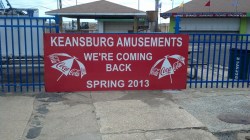
My first stop in Keansburg was the beach, which is getting ready for the summer season.
The amusement park was full of construction projects, but it looked like the kind of thing that might happen any year in the normal course of getting ready for the summer crowds. I talked to one restaurant owner who said he’d been open for a while, and a construction worker who told me he was looking to find a condemned house to buy, gut, and rebuild. He sounded hopeful. Out of the rubble emerges economic opportunity, I thought to myself.
From the beach I drove 8 blocks or so to the St. Marks Center for Community Renewal, where I was meeting Alyssa Durnier of Occupy Sandy, one of the key groups helping with recovery efforts, and the recipient of the Forecast the Facts donations.
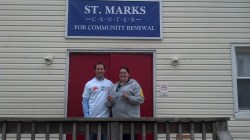
Me and Alyssa with a donation from Forecast the Facts members.
We quickly hopped in Alyssa’s truck and headed out for a tour. As we cruised around the streets, the first thing that caught my eye were the piles of rubble. They weren’t particularly dramatic. Just a mess of boards and trash bags and other crap. But they were everywhere. This, I realized, was what remains when people have to gut their houses because everything inside has been destroyed.
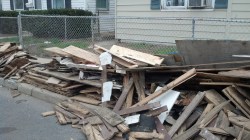
Piles of rubble where everywhere I went in Keansburg.
Alyssa pointed out which streets had been underwater. In many places, water lines were still evident. We stopped to say hello to some guys doing construction work (Alyssa seemed to know everyone) and it dawned on me that every single person we spoke with or saw on the street, was engaged in some kind of construction or cleaning or rebuilding project. I mean everyone. One guy patching a roof. Another woman dragging tree limbs off her yard. Another one moving piles of trash. It’s the kind of thing that you would expect in the weeks after a big storm. But six months later? The water has long been gone from Keansburg, but for residents, the months since have been one continuous digging out project, which is not even close to being done.
One of the misleading things about a town that’s been flooded is that the houses are generally still standing. At least that’s the way it was in Keansburg. But just because a house is erect doesn’t mean it’s liveable. Alyssa called up a friend to show me what his home looked like. The bottom floor was gutted and full of mold, and the water had actually moved the house 4 inches off of its foundation.

A house in the process of being gutted.
I asked about insurance, with heartwarming All State commericals somewhere in the back of my mind. But if there is a place where insurance agents show up the day after a storm with a helping hand and a big check, it’s not Keansburg. Everyone I talked to had a story about how their insurance was dragging their feet, refusing to pay, or offering tiny sums that wouldn’t begin to address the probelm. And while government money has been allocated to help people out, according to Alyssa, none has arrived as yet.
Keansburg is not a wealthy town, at least not the sections I found. And in many cases, people are simply not going to have the resources to rebuild. Alyssa mentioned several people who had just moved away, deciding it was easier and cheaper to just start over somewhere else. Some landlords had taken a different approach, slapping a coat of paint on a house and putting it up for rent again, without actually doing anything to take care of the mold or structural problems. In any case, a lot of the houses affected by the storm still lay empty, and will eventually just have to be knocked down. For now they stand as a ghostly memorial to what the town looked like before the storm.
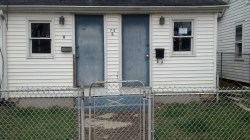
One of many houses in Keansburg that still stands empty.
Halfway through our tour, Alyssa’s truck broke down, apparently not an uncommon occurence. She seems to spend every waking hour doing some kind of recovery work, so hasn’t had the time to fix whatever is wrong with her pickup. We left the truck near her friend’s house and walked back to the community center, which shares a driveway with a church. As we cut across the lawn, Alyssa nonchalantly mentioned that we were walking over the church graveyard. All the stones had been washed away by the storm.
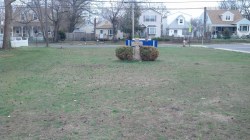
This used to be a graveyard. The stones were all washed away.
The graveyard’s disappearance seemed emblematic of what a disaster like Sandy wreaks. We cannot predict all the things that go horribly wrong when a town is submerged by 10 feet of salt water. Rebuilding will take years, not months. And in the process, some part of the town’s essence is washed away, never to return.
So yes, Keansburg is still reeling from Sandy. My guess is that the town will forever divide its history between before and after Sandy. Thankfully there are people like Alyssa Durnien who are working hard to build a bridge between those two eras. But she is going to need a lot of help. In dealing with a world defined by climate change, we all will.



